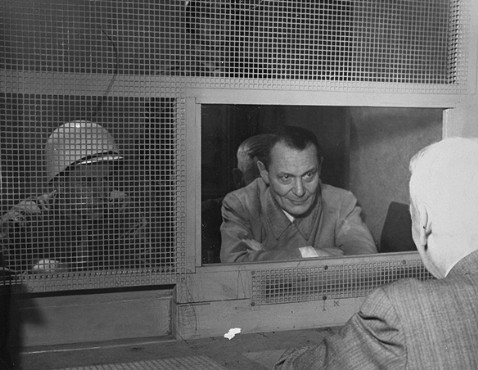
Date: 1946
Locale: Nuremberg, [Bavaria] Germany
Photographer: Ray D'Addario
Credit: National Archives, courtesy of USHMM Photo Archives
Copyright: Public Domain
 |
|
Defendant Hermann Goering consults with his lawyer, Dr. Otto
Stahmer, in the Nuremberg prison at the International Military
Tribunal trial of war criminals.
Date: 1946 Locale: Nuremberg, [Bavaria] Germany Photographer: Ray D'Addario Credit: National Archives, courtesy of USHMM Photo Archives Copyright: Public Domain |
Hermann Goering (1893-1946), was Commander-in-Chief of the Luftwaffe, President of the Reichstag, and initially Hitler's chosen successor. He first gained recognition as a World War I fighter pilot. He joined the NSDAP in 1922 and participated in the Beer Hall Putsch in 1923. He became a valuable asset to Hitler, using his connections in the army and business to gain support for the NSDAP. Upon Hitler's appointment to the chancellorship, Goering was rewarded with high positions, including Commander-in-Chief of the Prussian Police and Gestapo, and Commissioner for Aviation. Goering set up the first concentration camps and organized the Gestapo with Heinrich Himmler and Reinhard Heydrich. In 1935 he was appointed Commander-in-Chief of the Luftwaffe and in 1936, Plenipotentiary of the Four Year Plan. In the aftermath of Kristallnacht, it was Goering who instructed Heydrich to prepare a "General Solution" to the Jewish problem. In June 1940, Goering was named Reich Marshal, a special position, reflecting Hitler's high regard for him. However, after the defeat of the German Luftwaffe in the Battle of Britain, Goering's influenced waned. Following the German surrender, Goering was captured and put on trial in Nuremberg. He emerged as the dominant figure among the accused Nazis, sometimes successfully defending himself against the accusations of the prosecution. Nevertheless, he was convicted and sentenced to death. On October 15, 1946, just two hours before his scheduled execution, he committed suicide by swallowing a cyanide capsule he managed to smuggle into prison. |